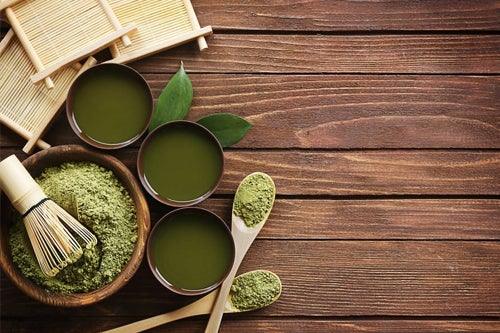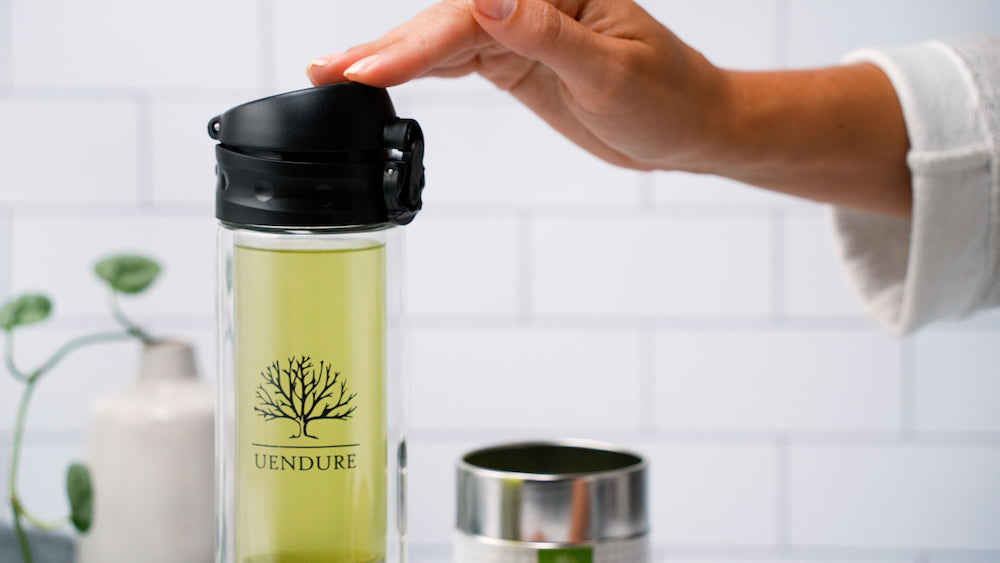Save 15% when you buy the Original Bottle Bundle!

History and Health Benefits of Japanese Matcha Green Tea
Green tea is considered the healthiest form of tea due to the lack of processing, which results in very high nutrient levels. Matcha green tea was originally produced and consumed in Japan. Because the entire leaf is ground and consumed in powder form, it is the most potent green tea in the world.
What does Matcha Mean?
In Japanese “cha” means tea, and “ma” means powder, thus the word matcha translates quite literally as “powdered green tea.”
Since the tea leaf is native to China, it is believed that the first green tea seeds were brought to Japan by the Chinese Zen Monk Eisai in 1191 A.D. Eisai, who also introduced the Zen philosophy to Japan, was the first to grind and consume green tea leaves in the powdered form. Thus Zen practice and matcha consumption became associated in the form of an elaborate tea ceremony.
The tea ceremony highlights the exquisite beauty present in simple things and is intended to bring all participants into the here and now. The drinking of matcha as the central point of the tea ceremony was an appropriate choice because matcha stimulates the mind with mental alertness while promoting a calm, meditative state of being.
Health Benefits of Matcha
There is a growing body of work cataloging the numerous benefits of matcha tea, from weight loss to mental acuity. Here are some of the key health benefits found in matcha tea.
- Antioxidants including the powerful EGCg
- Boosts metabolism and promotes burning calories
- Detoxifies the body effectively yet naturally
- Calms the mind while relaxing the body
- Mood enhancement and concentration
- Provides vitamin C, selenium, chromium, zinc and magnesium
- Can lower cholesterol and blood sugar
Why is Matcha Tea So Potent as an antioxidant?
The concentration that occurs with drying and grinding make matcha the powerful antioxidant it is. An antioxidant is a naturally occurring chemical compound that combats aging and many chronic diseases. Tufts University learned that matcha is known to have 20 times the antioxidant properties of blueberries or pomegranates. The benefits to people with cancer are also being studied by many organizations.
How to Make Matcha
Most people have had the experience of placing a tea bag in a cup of hot water or even placing loose tea leaves into a press or a pot but the proper methods of preparing matcha tea may not be obvious to those who have never consumed it.
The most common way to use matcha powder is to make tea, but matcha green tea is traditionally made in a very unique and specific way:
- Fill a tea kettle with fresh, filtered water and heat to almost the boiling point.
- Fill matcha bowl or cup with hot water and pour out in order to warm the drinking element.
- Add 1 teaspoon of matcha powder to the bowl or cup.
- Add 2 ounces of nearly boiled water.
- Whisk (ideally with a bamboo brush or tea whisk) water and powder briskly for a minute or two until it appears thick and frothy.
- Add another 3 to 4 more ounces of water.
Side-effects of Matcha
Reported ill effects of too much matcha consumption may be one or more of the following:
- Headache
- Vomiting
- Nervousness
- Sleep issues
- Ringing in the ears
- Diarrhea
- Dizziness
Many of these side-effects may be related to the relatively high levels of caffeine in matcha and green tea in general, both have less caffeine than conventional coffee. Whether one wants to explore the health benefits of matcha tea is a personal decision, but as far as tea consumption in general, matcha is growing in popularity outside Japan.


